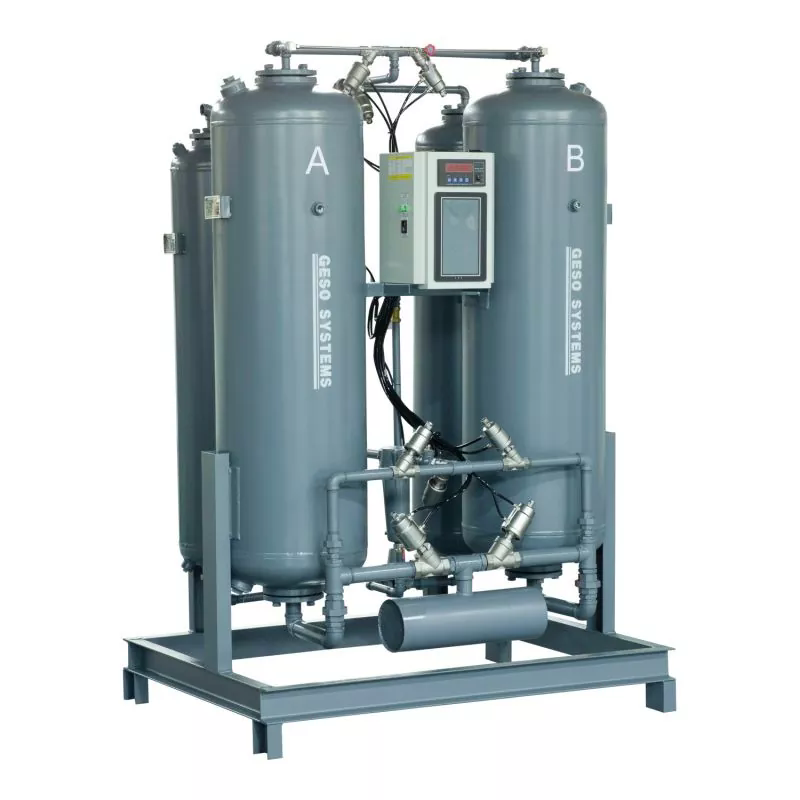Nitrogen Generators: A Smart Solution for Industrial Nitrogen Supply
2025-04-29
In today’s world, where industries rely heavily on specialized gases for a wide range of applications, nitrogen generators have become an indispensable tool. These generators offer a cost-effective and efficient alternative to traditional nitrogen supply methods like gas cylinders or liquid nitrogen delivery.

But what exactly is a nitrogen generator, and how does it work? Let’s dive into the details of these impressive machines and explore why they’re becoming the go-to solution for industries worldwide.
How Does a Nitrogen Generator Work?
Nitrogen generators work based on one of two common technologies:
1. Pressure Swing Adsorption (PSA)
The Pressure Swing Adsorption (PSA) method is the most commonly used process in nitrogen generators. Here’s how it works:
- Air Intake: The nitrogen generator draws in ambient air, which contains around 78% nitrogen, 21% oxygen, and small amounts of other gases.
- Adsorption Process: The air is passed through an adsorption vessel filled with a material known as zeolite. Zeolite has the ability to adsorb oxygen, carbon dioxide, and other gases, leaving behind nitrogen.
- Separation: The nitrogen gas is then separated and stored, while the oxygen and other gases are vented out. This process is repeated in cycles to ensure continuous nitrogen supply.
2. Membrane Nitrogen Generation
In the membrane separation process, air is passed through a special membrane that selectively allows nitrogen to pass through while rejecting other gases like oxygen and carbon dioxide. The separated nitrogen is then collected and stored for use.
While PSA is more common for high-purity nitrogen production, membrane systems are often used in applications requiring lower nitrogen purity and where a more compact system is desirable.
Why Choose a Nitrogen Generator?
Here are some reasons why industries prefer nitrogen generators over traditional methods of nitrogen supply:
1. Cost Efficiency
Buying nitrogen in cylinders or ordering liquid nitrogen deliveries can be expensive, especially for industries with high nitrogen consumption. A nitrogen generator eliminates ongoing gas supply costs by allowing businesses to produce their own nitrogen on-site. While the initial investment in the generator might be significant, the long-term savings are substantial.
2. Continuous Supply
With a nitrogen generator, you get a continuous, on-demand supply of nitrogen. This is particularly useful for industries where nitrogen is needed at high volumes and with little interruption. You no longer need to worry about running out of stock or the logistics of reordering gas tanks.
3. High Purity
Nitrogen generators are capable of producing nitrogen with a high level of purity, often reaching 99.99% or higher, depending on the application. This is crucial for industries like electronics, pharmaceuticals, and food packaging, where nitrogen purity directly affects the quality and safety of the final product.
4. Space and Energy Efficiency
Modern nitrogen generators are compact and energy-efficient. They occupy less space compared to storing large gas cylinders or tanks and use significantly less energy than traditional liquid nitrogen production methods. As a result, they are ideal for businesses with limited space or those looking to reduce their overall energy consumption.
5. Environmental Benefits
By generating nitrogen on-site, businesses can reduce their carbon footprint associated with transportation and storage of nitrogen gas. This is particularly important for companies looking to make their operations more sustainable.
6. Safety and Convenience
Handling large nitrogen cylinders or cryogenic tanks can pose safety risks, including accidental leaks or the danger of freezing injuries from liquid nitrogen. Nitrogen generators eliminate these hazards, providing a safer and more convenient alternative for producing nitrogen gas.
Applications of Nitrogen Generators
Nitrogen generators are used across a wide range of industries. Some of the most common applications include:
1. Food and Beverage Packaging
Nitrogen is often used in the food packaging industry to displace oxygen and extend the shelf life of perishable products. Nitrogen generators provide a cost-effective way to supply nitrogen for packaging processes like modified atmosphere packaging (MAP) and nitrogen flushing.
2. Electronics Manufacturing
In electronics, nitrogen is used to create an inert atmosphere for soldering and component assembly. High-purity nitrogen ensures that delicate components are not exposed to oxygen or moisture, preventing oxidation and corrosion during production.
3. Pharmaceuticals and Medical
Nitrogen is widely used in the pharmaceutical industry for inerting, preservation, and packaging processes. It helps maintain the integrity of products by protecting them from oxygen and moisture. Additionally, nitrogen is used in medical applications like MRI machines and cryopreservation.
4. Oil and Gas Industry
In the oil and gas industry, nitrogen is used for well purging, inerting tanks, and pipeline testing. It is also used in enhanced oil recovery to help extract more oil from the ground.
5. Laser Cutting and Metal Fabrication
Nitrogen is commonly used in laser cutting and welding processes, where it serves as an inert gas to protect materials from oxidation during cutting or welding. A nitrogen generator ensures a steady supply of nitrogen for these high-precision operations.
6. Laboratories and Research
Many laboratories require nitrogen for various processes, including chromatography, inerting reactions, and purging equipment. A nitrogen generator provides a reliable source of nitrogen for scientific applications.
Choosing the Right Nitrogen Generator
When selecting a nitrogen generator, consider the following factors:
- Nitrogen Purity: Ensure that the generator meets the required purity level for your application. Some industries, like pharmaceuticals or electronics, require ultra-high purity nitrogen.
- Flow Rate: Choose a generator that can produce enough nitrogen to meet your operational needs. The required flow rate will depend on your nitrogen consumption and the scale of your operations.
- Energy Efficiency: Look for energy-efficient models that help reduce operational costs and environmental impact.
- Space Requirements: Consider the physical size of the nitrogen generator and ensure it fits within your available space.
Conclusion
Nitrogen generators are a game-changing solution for industries that rely on nitrogen for various applications. Offering cost savings, continuous supply, high purity, and environmental benefits, these machines are an essential investment for businesses looking to streamline their nitrogen supply chain. Whether you’re in food packaging, electronics manufacturing, or pharmaceuticals, a nitrogen generator provides a safe, reliable, and efficient alternative to traditional nitrogen sources.
By adopting a nitrogen generator, you can not only enhance operational efficiency but also reduce costs and improve the sustainability of your business. With the technology and efficiency of today’s nitrogen generators, industries can now have more control over their nitrogen supply than ever before.


